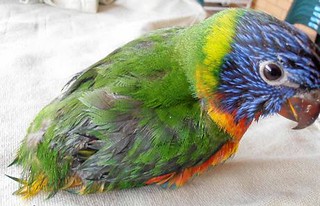Rainbow lorikeets eating meat leaves bird experts astonished
 Monday, March 23, 2015 at 12:40
Monday, March 23, 2015 at 12:40  Trichoglosus haematodus - Rainbow Lorikeets | in
Trichoglosus haematodus - Rainbow Lorikeets | in  Oddities
Oddities
 Monday, March 23, 2015 at 12:40
Monday, March 23, 2015 at 12:40  Thursday, November 27, 2014 at 14:28
Thursday, November 27, 2014 at 14:28  Rainbow Lorikeet (Trichoglossus haematodus) in a Black Bean tree (Castanospermum australe). Photo taken in the Royal Botanic Gardens in Sydney, Australia. The lorikeet is feeding on the nectar of the flowers.Image by Philip BouchardSuburban landscapes provide more consistent floral nectar than native bushland and support a greater abundance of large nectar-feeding birds
Rainbow Lorikeet (Trichoglossus haematodus) in a Black Bean tree (Castanospermum australe). Photo taken in the Royal Botanic Gardens in Sydney, Australia. The lorikeet is feeding on the nectar of the flowers.Image by Philip BouchardSuburban landscapes provide more consistent floral nectar than native bushland and support a greater abundance of large nectar-feeding birds
 Friday, October 10, 2014 at 3:39
Friday, October 10, 2014 at 3:39  Tuesday, August 26, 2014 at 9:44
Tuesday, August 26, 2014 at 9:44  Monday, August 18, 2014 at 3:46
Monday, August 18, 2014 at 3:46  DISEASE STRIKES: A young rainbow lorikeet recently rescued from East Ballina showing signs of beak and feather disease.LORIKEETS on the Northern Rivers are being struck down by a disease which affects their ability to fly.
DISEASE STRIKES: A young rainbow lorikeet recently rescued from East Ballina showing signs of beak and feather disease.LORIKEETS on the Northern Rivers are being struck down by a disease which affects their ability to fly.
Chrisy Clay from the Northern Rivers Wildlife Carers said the beak and feather virus was not uncommon, but that it had increased suddenly in recent weeks.
"Beak and feather disease is a virus found in both wild and pet parrots that affects the growth and development of their feathers and beak," Ms Clay said.